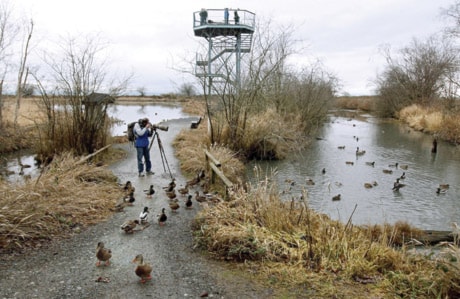DELTA, B.C. — Paparazzi wielding cameras fitted with long lenses collectively hold their breath to get the best shot of their preening subject.
Angelina Jolie?
No, it’s a northern hawk owl, which has only been spotted three times in the past 30 years in southern British Columbia.
About two dozen avid bird photographers crowd a road on Westham Island, where the Fraser River meets the Strait of Georgia. Their camera shutters click frantically as the owl leaves its perch on a telephone pole and flies to the roof of a nearby house.
To an amateur, the owl looks a lot like those plastic owls sold at the local hardware store to scare pigeons away. But Kathleen Fry of the nearby Reifel Bird Sanctuary says it’s a “photographer’s delight” because it hunts during daylight, so the “bird paparazzi” can get their shots.
The owl is one of many birds of prey to converge on the sanctuary for the winter. Because of the relatively warm climate, it’s one of the few bird sanctuaries in Canada where visitors can still see thousands of birds during the colder fall and winter months.
Thousands of snow geese — which have made a 4,000-kilometre flight from Russia’s Wrangle Island in the Arctic Ocean to the sanctuary in Ladner, B.C. — set off a noisy show for visitors as an eagle flies overhead.
Their panic is awe inspiring as a massive flock leaves the bog, covering the sky with frenzied honking that rivals the sound of any 747 coming in for a landing at nearby Vancouver International Airport.
While many birds can be spotted on the drive to the sanctuary, for a small fee visitors can stroll through flocks of waddling ducks, secretly watch long-legged cranes and great blue herons from the several bird blinds set up along the river and spot hidden owls resting for the day.
With an eagle perched on the tree just above her, Fry, the sanctuary manager and a biologist, said many northern birds head there to winter along the Fraser’s delta.
“Right now we have, for example, a great congregation of bald eagles ... there’s also all the owls from the forested slopes because their prey, in the form of small song birds, is also down at sea level.”
The sanctuary is one of the few spots in the marshy area with a lot of big conifer trees, so birds of prey have good sites to roost.
It’s named after George C. Reifel, who bought the property in 1927. In 1972, the Reifel family agreed to a combination of land sale and donation to the federal government, on the condition the land be managed for the benefit of waterfowl.
The sanctuary isn’t just for experts. Fry estimates about 90 per cent of those who visit are amateur birders who haven’t been to the sanctuary before.
“It’s a great treat. Visitors have not seen owls in the wild before and they’re just ecstatic to see (them).”
During the Olympics, Fry said the sanctuary had visitors from around the world. Children are welcome and they especially love to feed the tiny black, white and brown chickadees.
Seed is for sale and the biggest lure are the black sunflower seeds. Kids standing still with their palms out will be visited by brave little chickadees fluttering down to snatch a seed. They’ll be off before the child can flinch.
Rick Green comes to the sanctuary every day he can.
Green, who’s in a wheelchair, calls himself an amateur birder, but he has nearly 35,000 pictures this year of 150 different species, most of them taken in the area.
“It’s a great migratory route and there’s a variety of different species around here, it’s incredible. (Even) in a bad day you’re looking at 20, 30, 40 different species, minimum.”
Mark MacDougall, from nearby Surrey, B.C., also visits the sanctuary often to see sandhill cranes, great horned owls and “about 10,000 snow geese.”
“It’s a beautiful spot,” he said.
If you go
• How to get there: The sanctuary is 13 kilometres west of Ladner in Delta, B.C. To drive, follow River Road west for three kilometres until you get to the single-lane bridge crossing onto Westham Island. Follow the only road that twists and turns to the very end of the tiny island.
• Fees: Admission is $5 for adults and $3 for seniors and children aged two to 14.
• Hours: The sanctuary is open from 9 a.m. to 4 p.m. every day, including holidays. It gets about 70,000 visitors a year, and Mother’s Day is the busiest.
• Online: www.reifelbirdsanctuary.com
